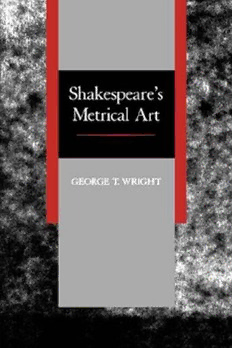
Shakespeare's metrical art PDF
Preview Shakespeare's metrical art
Shakespeare's Metrical Art This page intentionally left blank Shakespeare's Metrical Art GEORGE T. WRIGHT UNIVERSITY OF CALIFORNIA PRESS Berkeley Los Angeles London This book is a print-on-demand volume. It is manufactured using toner in place of ink. Type and images may be less sharp than the same material seen in traditionally printed University of California Press editions. University of California Press Berkeley and Los Angeles, California University of California Press, Ltd. London, England ©1988 by The Regents of the University of California First Paperback Printing 1991 Library of Congress Cataloging-in-Publication Data Wright, George Thaddeus. Shakespeare's metrical art. Includes index. 1. Shakespeare, William, 1564-1616—Versification. 2. English language—Early modern, 1500-1700—- Versification. I. Title. PR3o85.W75 1988 822.3'3 87-10931 ISBN 0-520-07642-7 Printed in the United States of America The paper used in this publication meets the minimum requirements of ANSI/NISO Z39.48-I992 (R 1997) (Permanence of Paper). @ For Jerry, the long love that in my thought doth harbour This page intentionally left blank Contents Preface ix 1 The Iambic Pentameter Line 1 2 Chaucer and Wyatt: Early Expressive Pentameters 20 3 The Sixteenth-Century Line: Pattern and Variation 38 4 Flexibility and Ease in Four Older Poets 57 5 An Art of Small Differences: Shakespeare's Sonnets 75 6 The Verse of Shakespeare's Theater 91 7 Prose and Other Diversions 108 8 Short and Shared Lines 116 9 Long Lines 143 10 Shakespeare's Syllabic Ambiguity: More Than Meets the Ear 149 11 Lines with Extra Syllables 160 12 Lines with Omitted Syllables 174 13 Trochees 185 14 The Play of Phrase and Line 207 15 Shakespeare's Metrical Technique in Dramatic Passages 229 16 What Else Shakespeare's Meter Reveals 249 17 Some Metrically Expressive Features in Donne and Milton 264 18 Conclusion: Verse as Speech, Theater, Text, Tradition, Illusion 281 Appendix A: Percentage Distribution of Prose in Shakespeare's Plays 291 vii Contents Appendix B: Main Types of Deviant Lines in Shakespeare's Plays 292 Appendix C: Short and Shared Lines 294 Notes 297 Main Works Cited or Consulted 325 Index 339 viii Preface Poetry is language composed in verse, that is, language of which an essential feature is its appearance in measured units, either as written text or in oral performance. Although other units, larger or smaller, play an important part in poetry, in literate cultures the line is the indispensable unit of verse and the one by which we recognize its nature. Paragraphs of prose lack this essential feature: in different printed versions the separate lines may end at different words without injury to meaning or form; dif- ferent printed versions of poems must retain the lines as they are. If a line is too long to print on a narrow page or column, the printer must use some conventional means to show that the leftover words belong with the ones they follow. Even when the sense of one line runs over to the next, it is important to the form of a poem that the lines be preserved intact. If the line is the basic unit of a poetic text, meter and stanza measure the line in respect to units smaller or larger than the line. The meter of a line is its inner rhythmical structure, which in English we understand as a relationship between stressed and unstressed syllables. Since poems do not normally change their meter in every line but establish and confirm re- petitive rhythmical patterns, often we must read several lines of a poem before we can hear a pattern of stressed and unstressed syllables that in- heres in all of them, with or without variation. Once we can hear the basic pattern, we can recognize it as it is realized differently in all the succeeding lines; we listen for the returning pattern. Although the term stanza usually designates a particular arrangement of lines (a certain number of them in a design that may mix long lines and short, and with a specific patterning of rhymes), it is probably the best word we have to signify our more general interest in the way lines combine to form larger prosodic units. Meter lets us hear the line's inner relations, stanza its outer connections. ix
